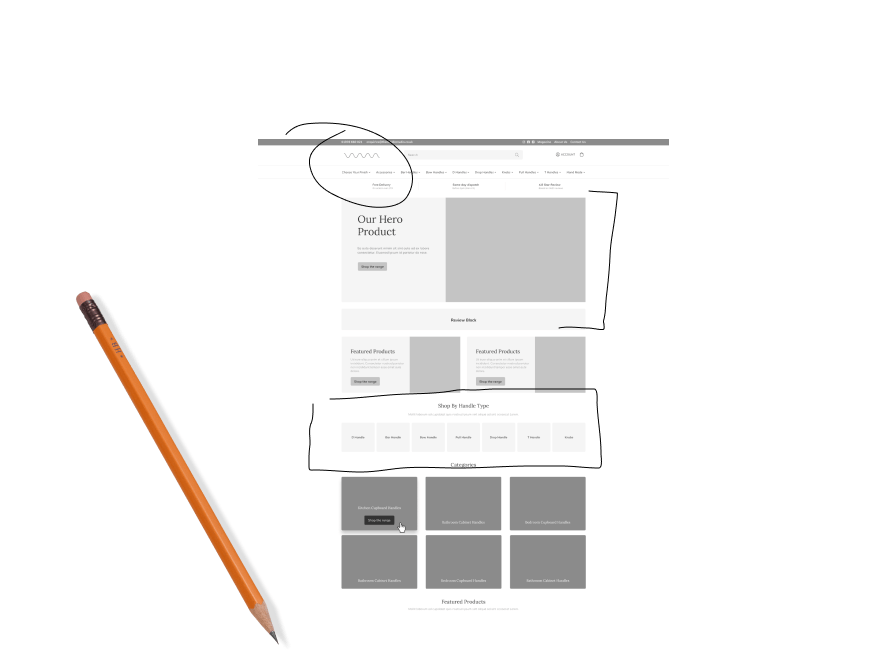SEO is crucial to running a successful ecommerce business, but have you optimised your product pages?
We’ve gathered 7 powerful ways to optimise your ecommerce product pages to ensure that you maximise conversion opportunities and delight your users. Whether it’s strategic keyword research you need a helping hand with or writing captivating product descriptions, we’ve got some helpful tricks up our sleeves to get you on your way to success.
Ready to elevate your product page game? Let’s dive in and discover the art of product page SEO!
1. Conduct keyword research
First up, keyword research is an absolute must when it comes to SEO in general, but particularly in terms of your product pages. Conduct extensive keyword research based around key topics and prevalent customer search queries to find valuable keywords to target within your product pages. By utilising tools such as Google’s Keyword Planner and Ahrefs, you can analyse the competitiveness of each keyword, get an idea of the search volume and find other keywords that your key competitors are ranking for. In turn, this enables you to narrow down your list of keywords to those that are most likely to bring you success.
Now you’ve got your keywords, it’s time to incorporate them within your product descriptions, headings, meta descriptions and alt descriptions for product images. Be sure to use them strategically and only where relevant to the context of your product as simply adding tons of keywords (dubbed “keyword stuffing”) is a sure-fire way to kill your credibility and will be seen as “spammy” by search engines.
2. Crafting compelling product descriptions
Now you’ve got a list of valuable target keywords, it’s time to craft compelling product descriptions that incorporate your keywords and drive customers to take action. When writing, be sure to have your target audience in mind and highlight how your product benefits them. Remember, this isn’t about you! Utilise persuasive and emotive language to encourage users to add your product to their cart and steer clear from simply writing a list of why your product is the best.
Whilst product descriptions should be informative, clear and concise, they should also be inspiring and reflect your unique brand values. Ensure your tone of voice is on point for your brand and your writing style is seamless between product descriptions and other website content.
3. Optimise product imagery
Product imagery is absolutely paramount to improving the user experience and driving conversions. Ensure your product imagery is professional, high-resolution and inspiring to maximise chances of delighting users and encouraging them to convert. Appealing to your target audience isn’t just about showcasing beautiful imagery, you must also ensure that images load at lightning-fast speed to avoid user frustration. There are many image optimisation software options out there so be sure to utilise these to ensure your images are compressed without sacrificing quality. Finally, be sure that files are named appropriately and target keywords are incorporated within file names and alt tags where possible.
4. Harness user-generated content
User-generated content (UGC) provides a fantastic opportunity to demonstrate how your products are impacting real people’s lives. By adding images of your products being used by customers within your product page, you’re sure to demonstrate trustworthiness, credibility and social proof. Furthermore, incorporating verified reviews, ratings and testimonials within your product pages is another way to instil trust and further demonstrate the positive impact your products are having in the real world. Not only that, showcasing UGC within your product pages also helps to build a community of likeminded people who share the love of your brand, and what could be better than that?
5. Prioritise page loading speed
Considering that 70% of consumers claim that page speed impacts their online purchase decisions, it’s clear that optimising product pages to run as fast and smoothly as possible, is key to converting customers. Whilst you should have already implemented image optimisation software to reduce image loading times, you can also implement additional techniques such as minifying code and leveraging caching to reduce loading times. It’s likely that you’ll need to enlist the help of some expert web developers for this part so be sure to reach out if you need a helping hand.
6. Ensure mobile-friendly design
The layout of your product page will directly impact the conversions you make. Employ a responsive and mobile-focused design to ensure that the layout of each product page is displayed in the best possible format for every device a user could possibly use to reach your website. Ensure that key information is clearly laid out and thumb-friendly navigation is implemented to make browsing from mobile an absolute breeze.
7. Utilise internal linking
Finally, internal linking is a fantastic strategy to help grow the visibility of your brand. As you write website content such as blog posts, articles and on-page content, consider how you can link to individual product pages. This will enable search engine crawlers to seamlessly navigate throughout your website and allow them to index product pages, leading to increased search visibility. Be sure to only link to products where it is relevant and enhances site navigation for customers, otherwise your efforts could be wasted.
And that’s a wrap on our 7 top tips for improving product page SEO! For more SEO news keep up with our blog and if you need a helping hand with anything mentioned in this article, be sure to get in touch!











